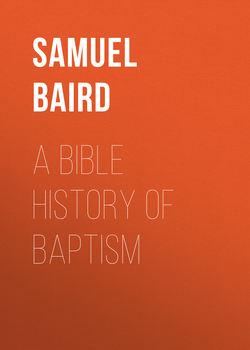Читать книгу A Bible History of Baptism - Baird Samuel John - Страница 18
Book I.
OLD TESTAMENT HISTORY
Part III.
ADMINISTERED BAPTISMS=SPRINKLINGS
Section XV. —Baptism of those defiled by the Dead
ОглавлениеThe purification of the leper must have been of rare occurrence. All the facts and indications of the Scriptures tend to the conclusion that, except by miraculous agency, the disease was incurable. The baptism of Israel at Sinai was extraordinary in its nature and circumstances, and could not have been repeated except in circumstances equally remarkable, such as that when, in the plains of Moab, the covenant was renewed with the new generation, which had risen up to take the place of those who perished in the wilderness. (Deut. xxix, 1.) But of that transaction the particulars are not recorded. In the water of separation, provision was made for an ordinary rite, essentially the same, in its nature, mode, and meaning, as the Sinai baptism; and so ordered as to serve as a continual memorial and repetition of it, and reiteration of the promises and instructions therein embodied. This rite was appointed for the cleansing of defilements of daily occurrence, and was maintained through all the after history of Israel, until the time of Christ, and the destruction of Jerusalem. It was known to the Jews by the name of baptism.
In preparation for this rite, a red heifer without blemish was chosen by the priest, and slain without the camp, whence the priest sprinkled the blood toward the door of the tabernacle of the congregation seven times. The entire heifer was then burned, while the priest cast cedar wood, hyssop, and scarlet into the burning. The ashes were gathered and laid up in a clean place, without the camp. (Num. xix, 2-10.) They were to be “kept for the congregation of the children of Israel for a water of separation.” – Ib. 9. By the phrase, “water of separation,” is not meant a water to cause separation, but a remedy for it. They were, as Zechariah expresses it, “for sin and for uncleanness.” – Zech. xiii, 1.
The primary case for which they were provided was that of defilement by the dead. (Num. xix, 17, 18.) Whoever touched a dead body or bone of a man, or a grave, was defiled thereby, as was the tent or house where the body lay, and the furniture and utensils that were in it. For the purifying of these, some of the ashes of the heifer were mingled, in an earthen vessel, with running water. A clean person then took a bush of hyssop, and, dipping it into the water, sprinkled it on the persons or things to be cleansed. This was done on the third day, and repeated on the seventh. “And on the seventh day he shall purify himself, and wash his clothes, and bathe himself in water, and shall be clean at even.” – Num. xix, 2-19. Thus, as in the case of the leper, the rites for defilement by the dead were divided into two categories, – those administered by the priest or a clean person acting officially, and those performed by the subject himself. The importance of the distinction thus made between rites administered and those self-performed is worthy of repeated and emphatic notice. The former symbolized Christ’s and the Spirit’s agency; the latter, the active personal obedience and holiness of the believer’s life.
It appears from the rabbins that, at least during the later period of Jewish history, the purifying of persons was, whenever practicable, performed at Jerusalem, by the hand of a priest, and with water drawn from the pool of Siloam, which flowed from the foot of the temple mount. For the purifying of houses and other things, the ashes were sent throughout the land, and the rites performed where the uncleanness was contracted.
